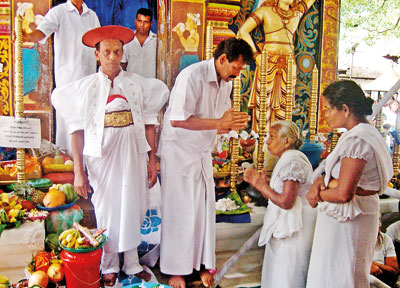After the perahera, blessing from the deity
View(s):By Udumbara Udugama
People seek blessings from supernatural forces and deities for protection and prosperity through festivals and by performing ceremonies and rituals.
After the conclusion of the Esala Maha Perahera in Kandy on August 18 with the Daval (day) perahera, another ceremony was conducted at the Maha Vishnu Devalaya in Kandy from August 19, to ward off evil effects on those who took part in the perahera – the Diyawadana Nilame, the Devala chieftains, drummers, dancers, elephants and their mahouts and all others who had played a part. This ceremony conducted for seven days is a Shantikarma known as Hath Da Vali Yakun Netuma or Valiyak Mangalya.
In the past, the Vali Yakun Netuma was performed in Natha, Kataragama, Pattini Devalaya in Kandy, Wallahagoda Devalaya in Gampola and Aluthnuwara Devalaya close to Hingula on the Colombo-Kandy road. It is now performed only at the Maha Vishnu Devalaya in Kandy.

Alatti Ammas being greeted by the Kapu Mahattaya
Nissanka Devanagala, the Yakdessa explained the rituals that are performed at the Valiyak Netuma. His father, Gurunnanse W.P. Simon Devanagala, the main Yakdessa from Hatarakorale near Aluthnuwara had danced until last year, upto the age of 93. As he passed away on February 16 this year, Nissanka Devanagala has taken over and performed the ceremony at the Maha Vishnu Devalaya this year.
On the first day Solos Magala is drawn on the floor and they sing Stothras and “pey karanawa”. The Devalaya has to provide the Yakdessa with raw rice, 12 Sivili Walang (small clay pots), coconuts, betel leaves, Panduru(coins) and flowers. On the 19 th, the Gavaramala (coconut flower – florescence was hung on the roof of the Hevisi Mandapaya and they start their sthothra gayanaya around 7.30 in the evening for about two hours. “We do not wear the Ves costume,” he says. “On the 20th, the second day it was the “Deva aradanawa”. “We bring down the Gavaramala, sing the sthothras and raise it again. On the 21st, “Magul Bera saha Atthiya Bera vadanayen pasu Yakanuma natanawa, deva aradhanawata.” On August 22, 23 and 24 it was the same ritual.
On the night of the 24th, “Magul Bera, Attiya Bera, Kola Mura Hath Pada Paliya Deviyan wenuwen natanawa. Pada pahak natanawa, bulath padey, kothala padey, dummala padey, salu padey, seth padey.” In the morning “Siviliya wedamawa yathika karanawa.” At 2 in the morning they bring the Siviliya and say stothras(yathika karanawa). They dance the two Yakka – Veddha yakkama and Naya yakkama. The Diyawadana Nilame and the four Devala Nilames are blessed and the ritual concluded before the morning Tevava of the Sri Dalada Maligawa.
On the seventh and the final day, August 25, the ritual began at 2 in the afternoon. The Basnayake Nilame Mahindra Ratwatte was present and lit two oil lamps before the ceremony began. The Gavaramala was brought down and the three Yakdesso danced around it.
Two Alatti Ammas dressed in white prepared the rice for the pooja. The Gavaramala was carefully brought down to the floor of the Hevisi Mandapaya and people rushed to collect the florescence, picking up the tiny florets that were on the floor as they believe it brings them good luck and prosperity. The Police and the Devale officials tried hard to control the people and give everyone a chance to collect at least one floret, considered very precious to them.
The main Yakdessa sat at the entrance to the Devalaya and people tied panduru (coins) on his Jatava (the long strip of cloth – patiya) which hangs from his head-dress. Thereafter the Gara Yaka, the Yakdessa with a Devil mask came asking for Valapalam, Soru (bananas, rice )and Kevum. Once these items were offered, he ran away repeating sthothras, clearing all the dos- evil spirits to Santhana Adaviya, a jungle area.
Many young people were among the crowd who had come to witness the ceremony.
Ruwan Chamara from Katugastota, 22, said that he has been to seven Valiyak Mangalyas. He had been there the whole night on the 24th. His friend Karunaratne said he has a great belief in Vishnu Deiyo and has his “pihita” blessings. He has been attending this ceremony for the last 10 years.
It was the first time for 23-year-old Vatsala Rajapakse from Pujapitiya and for R.M. Leelawati, 52, from Embilmeegama, Pilimatalawa who professed great faith in Vishnu Deiyo. P.R.M. Kumari who is 33 years old came because her mother wanted her to come and it was her first time.
Mr. Weerasooriya, 62, a businessman who owns Pallemulle Stores in Katugastota has been attending this ceremony for the last five years. He has a ‘great ‘Bhaktiya’ devotion to Vishnu Deiyo. The florets he collected during the past years are still with him wrapped in a Bulath Kole (betel leaf) in a drawer in his business premises. “I will keep them always. It is good to keep some in your purse too. It brings good luck,” he said.
Visaka Rajakaruna had a different reason for attending. She had made a vow to Vishnu Deiyo after marriage that she should have a child and now “my baby is five months old and I brought her to fulfill the vow,” she said.
Isuri and Ruwanthi de Silva, two sisters, from Hillwood College and Swarnamali Girls School were witnessing the ritual for the first time with their family. Their mother Dhammika said that she has “Bhaktiya and the Seth Shanthiya ape jeevitayata hondai.” Donald de Silva, a Pastry Chef in a hotel in Beruwala said he wanted his daughters to know about these ceremonies. “The young generation should understand our culture.”


